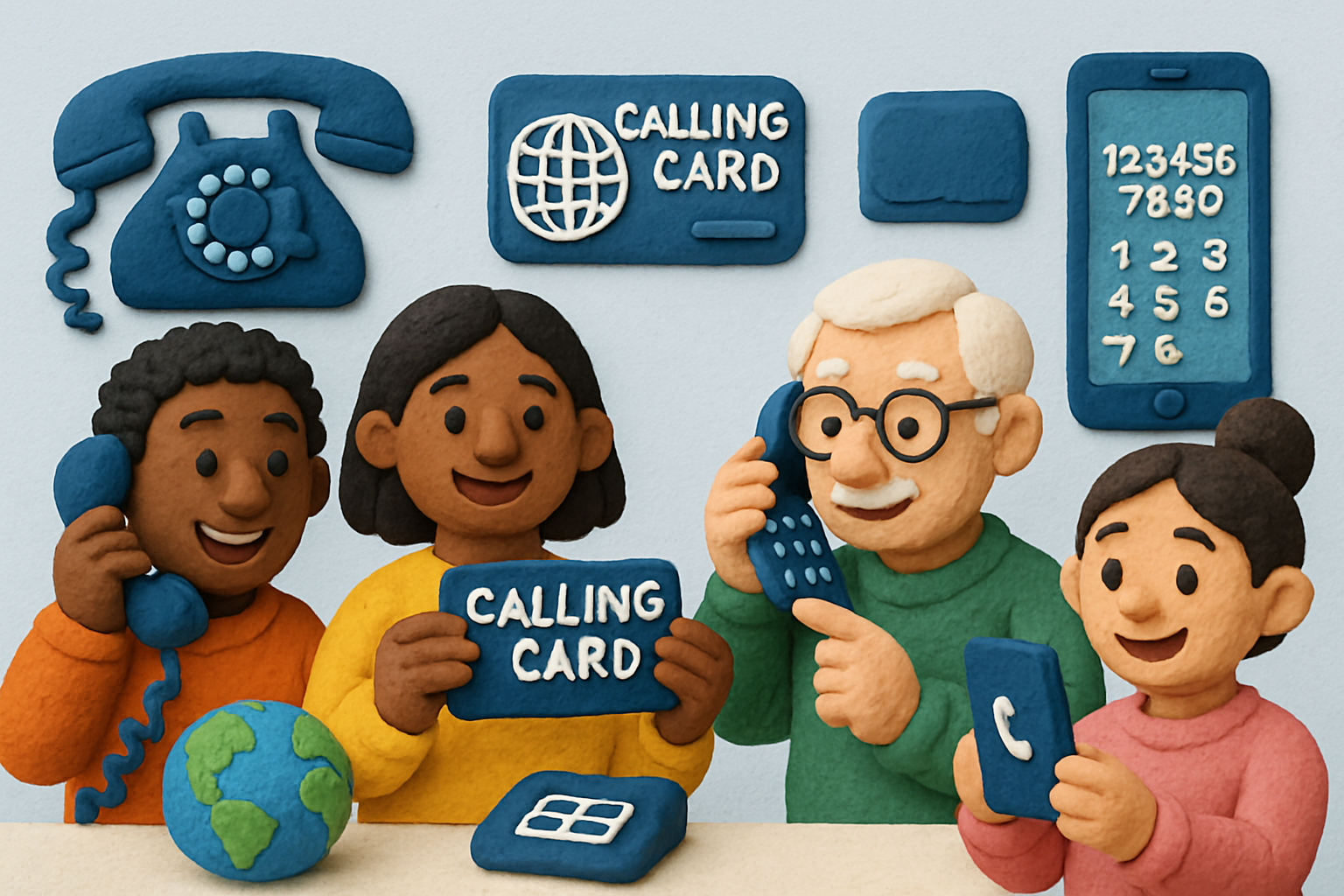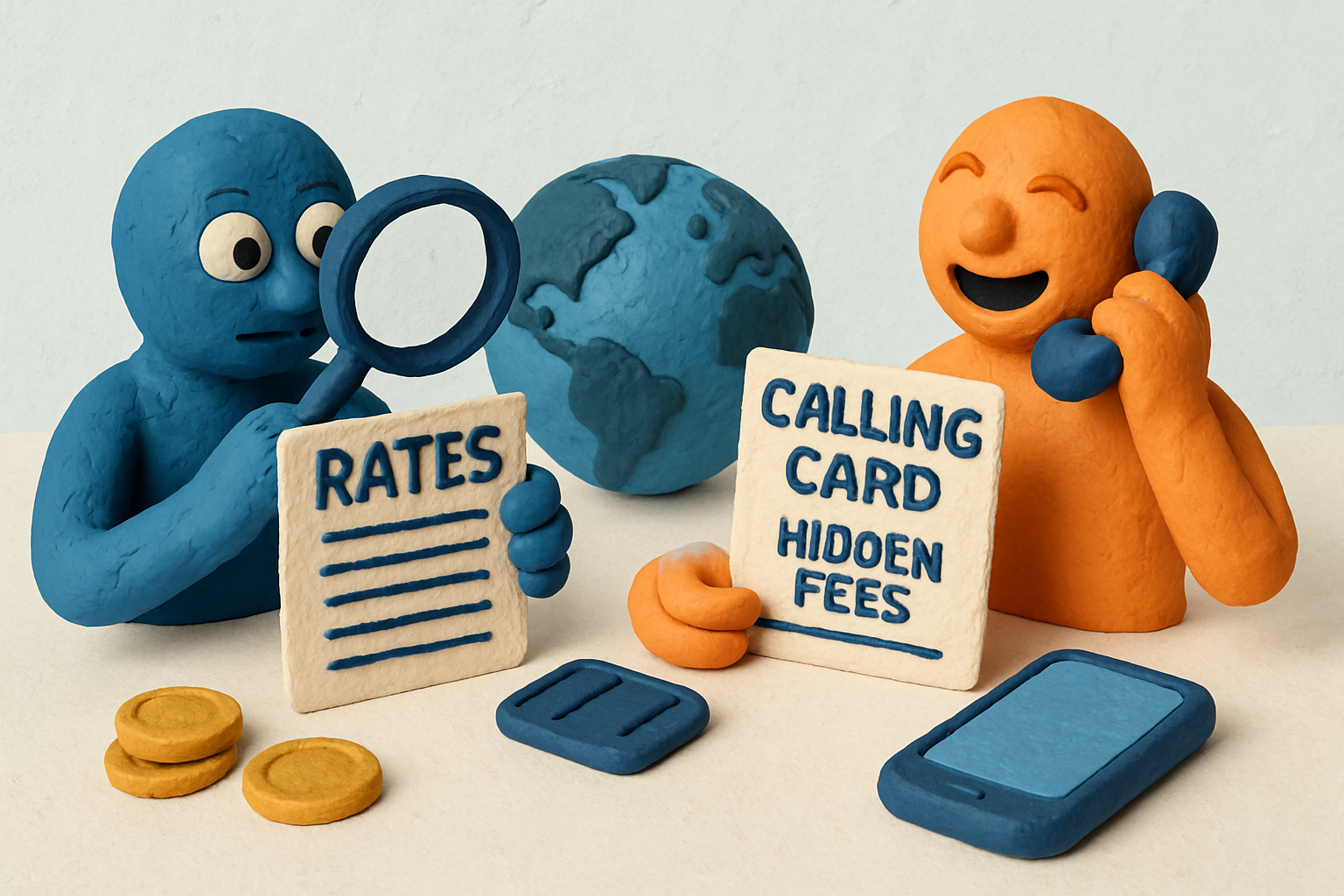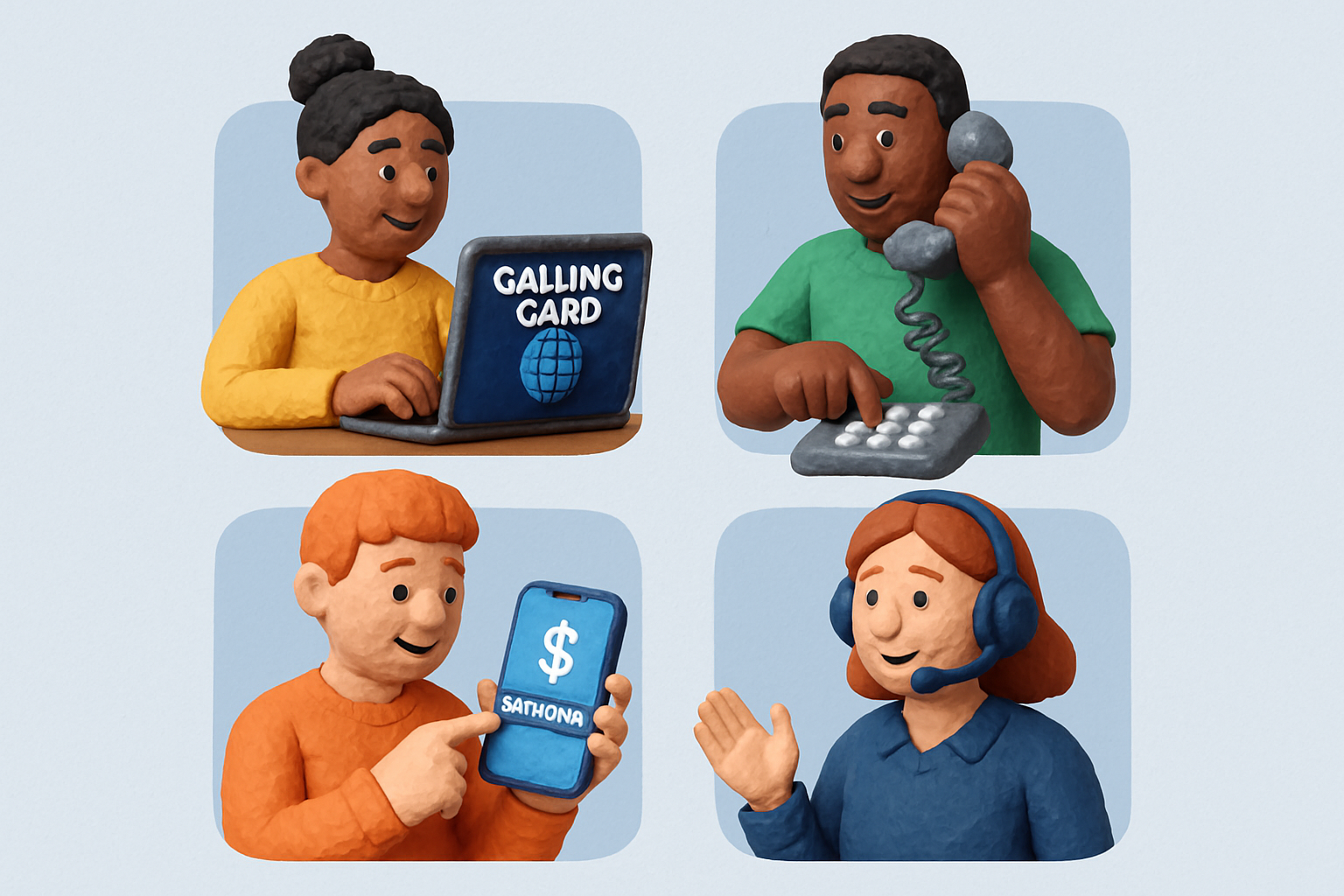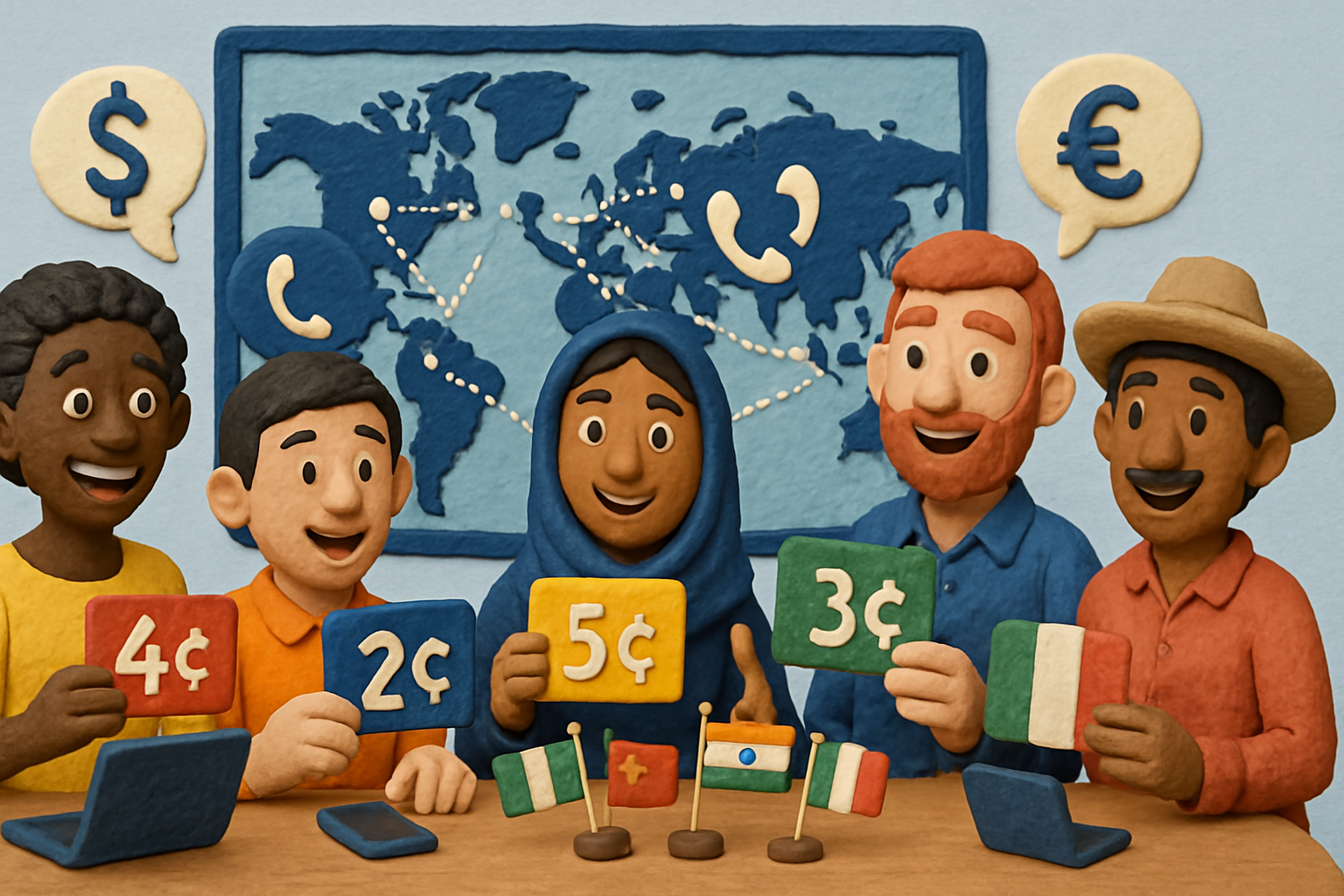
Imagine reaching friends, family, or business partners across continents—without sky-high phone bills or dropped calls. Global communication is more important than ever, and making the right choice can save you time and money.
This ultimate guide explores everything you need to know about using a calling card for international calls in 2025. Whether you’re a traveler, an expat, or just want to stay connected, you’ll find practical tips and honest comparisons.
Discover how calling cards work, the types available, how to choose the best card, setup steps, top providers, and expert advice for smarter, cheaper international calling.
Understanding Calling Cards for International Calls
Imagine wanting to reach friends, family, or colleagues overseas without worrying about sky-high phone bills. That’s where the calling card for international calls comes in. Let’s break down what these cards are, how they’ve evolved, and why they’re still relevant in 2025.

The Evolution of Calling Cards
A calling card for international calls began as a simple, physical card sold at convenience stores. You’d scratch off a panel to reveal a PIN, dial an access number, and then make your overseas call. Over the years, these cards have transformed. Today, many people buy digital or virtual cards online, receiving their PIN instantly by email or app notification.
This shift from plastic to digital means more convenience and less waste. Still, the core purpose remains: making international calls affordable and accessible to everyone.
How International Calling Cards Work
At the heart of every calling card for international calls are three key components:
- Access Number: The local or toll-free number you dial to reach the card’s system.
- PIN: A personal identification number that unlocks your prepaid balance.
- Rate Structure: The per-minute cost, which varies by country.
To make a call, you dial the access number, enter your PIN, and then the destination number. The provider routes your call through their network, often using the most cost-effective path. For a deeper dive into how this process works, check out the Ultimate Guide to International Telephone Cards.
Advantages and Limitations
Why choose a calling card for international calls over regular phone services? Here are some benefits:
- Cost Savings: Lower rates compared to direct dialing.
- Flexibility: Use from any phone—landline, mobile, or payphone.
- Accessibility: Available online and in stores, with options for many countries.
However, there are some drawbacks:
- Hidden Fees: Connection or maintenance fees can eat into your balance.
- Call Quality: Sometimes affected by network routes or access number congestion.
- Access Issues: Local access numbers may not always work in certain regions.
Real-World Cost Comparison
Let’s compare: Calling India directly from a US mobile might cost $1.50 per minute. Using a calling card for international calls, that same call could cost as little as $0.03 per minute. Over a one-hour call, you’d save $87!
| Method | Cost per Minute | 1-Hour Call Cost |
|---|---|---|
| Direct Mobile | $1.50 | $90.00 |
| Calling Card | $0.03 | $1.80 |
This illustrates how a calling card for international calls can make a huge difference for frequent callers.
Global Trends and Statistics
The demand for calling card for international calls remains strong. In 2024, industry reports showed over 500 million active users worldwide, with digital cards accounting for 65% of sales. By 2025, experts predict a 10% annual growth in virtual card adoption, especially among students, expats, and small businesses.
Despite the rise of internet-based calling apps, many still rely on calling cards for their reliability, simplicity, and reach—especially in areas with limited internet access.
Key Features to Look for in a Calling Card
Choosing the right calling card for international calls can feel overwhelming, but focusing on a handful of essential features makes all the difference. Whether you’re calling family or handling business abroad, a smart choice ensures every minute—and every cent—counts.

Transparent Rates & Hidden Fees
Always check the per-minute rates advertised by each calling card for international calls. Look beyond the big, bold price: read the fine print for connection fees, maintenance charges, rounding increments (like billing in 3-minute blocks), and surcharges for calling mobiles or certain countries.
Some cards look cheap upfront but carry hidden costs that eat up your balance. Use resources like the Cheap International Calling Cards Guide to compare true costs and avoid nasty surprises.
Access Methods & Card Validity
A reliable calling card for international calls should offer multiple access numbers—local, toll-free, or mobile—so you can connect easily wherever you are. Local access numbers often mean cheaper calls, while toll-free numbers are more convenient but may cost more per minute.
Check the card’s validity period. Some cards expire after a set time or after your first use, while others allow recharges, so you keep unused credit. Pick a card that matches your calling habits and won’t let your balance slip away unused.
Call Quality & Reliability
High call quality is a non-negotiable feature for any calling card for international calls. Look for providers that invest in reliable networks and have a reputation for clear audio and stable connections. Dropped calls, delays, or poor sound can ruin the experience and waste your minutes.
Read user reviews and choose cards with proven reliability. Some providers offer HD voice or advanced call routing, which can make a noticeable difference, especially when calling countries with less robust telecom infrastructure.
Customer Support & Security
Responsive customer support is crucial when using a calling card for international calls. You might run into issues like invalid PINs, blocked numbers, or lost balances. Make sure the provider offers 24/7 support, clear refund policies, and multiple contact methods.
Security matters, too. Pick cards from trusted brands that protect your personal and payment information. Never share your PIN or purchase cards from suspicious sellers online or in-store.
Rate Comparison Table Example
Here’s a quick snapshot comparing rates and features for leading calling card for international calls providers in 2025:
| Provider | Rate to India (¢/min) | Connection Fee | Access Types | Rechargeable? |
|---|---|---|---|---|
| CardX | 1.2 | $0.50 | Local, Toll-free | Yes |
| CardY | 1.5 | $0.00 | Local | No |
| CardZ | 1.0 | $0.25 | Local, Mobile | Yes |
Always compare rates and features before buying a calling card for international calls, as the best option depends on your destination, call frequency, and preferred access method.
Step-by-Step Guide: How to Use a Calling Card for International Calls in 2025
Getting started with a calling card for international calls in 2025 may seem daunting, but the process is surprisingly straightforward. Whether you’re calling family overseas or managing business contacts, following these easy steps guarantees a smooth, affordable experience.

Step 1: Choose the Right Calling Card
Begin by researching the best calling card for international calls tailored to your needs. Compare providers, focusing on rates for your destination countries, card types (physical vs. virtual), and user reviews. Pay attention to card validity, recharge options, and customer support.
It’s smart to review provider comparisons, like those found in the Best International Calling Cards guide, to ensure you’re making an informed choice. Look for transparent rate structures and avoid cards with unclear fees. By taking time to compare, you maximize savings and minimize headaches.
Step 2: Purchase and Activate the Card
Once you’ve selected a calling card for international calls, purchase it through a reliable source—either at a local retailer, official website, or trusted app. Virtual cards are popular for instant delivery, while physical cards are still available at select stores.
After purchase, follow the provider’s activation steps. This typically involves registering the card, receiving a unique PIN, and checking your balance. Always buy from reputable sources and keep your PIN confidential to protect your calling card for international calls from fraud.
Step 3: Dialing the Access Number and Entering PIN
With your calling card for international calls ready, locate the correct access number. Providers usually offer local, toll-free, or mobile access numbers, which you can find on the card or provider’s website.
Dial the access number, then listen for prompts to enter your PIN. Enter the PIN securely and carefully. If you encounter issues—like the number not connecting or invalid PIN errors—double-check the details or consult your provider’s help section. Smooth access ensures your calling card for international calls works as intended.
Step 4: Placing Your International Call
Now it’s time to connect! Input the international destination number, always using the correct country and city codes. For example, calling from the US to India requires dialing the access number, entering your PIN, and then the full Indian number.
Listen for confirmation prompts before speaking. Monitor your call duration and remaining balance, so you don’t get caught off guard. Using a calling card for international calls gives you clear control over costs and connection quality.
Step 5: Managing Balance and Recharging
Stay on top of your calling card for international calls by regularly checking your remaining minutes and balance. Most providers offer online portals or apps for quick balance checks.
When your balance runs low, recharge through the provider’s website, app, or in-store options. Set up low-balance alerts if available. Don’t forget to monitor card expiration dates to avoid losing unused credit. This keeps your calling card for international calls ready whenever you need it.
Step 6: Troubleshooting and Support
Even the best calling card for international calls may encounter hiccups like dropped calls, invalid PINs, or blocked access numbers. When issues arise, reach out to customer support—most providers offer live chat, phone, or email assistance.
If you need a refund or dispute resolution, keep records of your calls and transactions for reference. In 2025, many providers pride themselves on fast response times and helpful support, so don’t hesitate to ask for help. With the right support, your calling card for international calls experience stays hassle-free.
Comparing the Best International Calling Card Providers in 2025
Choosing the right calling card for international calls can make a huge difference in your communication experience and monthly expenses. With so many providers on the market, it’s essential to know how to compare your options and find the best fit for your needs.

What to Look For: Criteria for Comparing Providers
When evaluating a calling card for international calls, keep these criteria in mind:
- Rates: Check per-minute rates for your most-called countries.
- Coverage: Ensure the calling card for international calls covers both landlines and mobiles in your destination.
- Reliability: Look for consistent call quality and minimal dropped calls.
- Fees: Watch for connection, maintenance, and rounding fees.
- Access: Consider if you prefer local, toll-free, or mobile access numbers.
- User experience: Review apps, online portals, and customer support quality.
These factors help you avoid surprises and maximize your savings with any calling card for international calls.
Comparing Top Providers: Features and Rates
Let’s look at how leading calling card for international calls providers stack up. The table below summarizes key features and sample rates for popular destinations:
| Provider | US to India (¢/min) | UK to Philippines (¢/min) | Coverage (Countries) | Hidden Fees | Mobile App | Customer Support |
|---|---|---|---|---|---|---|
| Talk Home | 1.5 | 5.0 | 200+ | Low | Yes | 24/7 |
| Provider B | 2.0 | 6.0 | 180 | Medium | Yes | Business Hours |
| Provider C | 1.8 | 4.8 | 150 | High | No | 24/7 |
| Provider D | 1.7 | 5.5 | 170 | Low | Yes | Email Only |
For an in-depth look at one of the most popular cards, check out this Talk Home International Calling Card Review. It dives into real-world experiences and detailed rate breakdowns.
User Experience, Security, and Privacy
A great calling card for international calls should be easy to use. Top providers now offer intuitive mobile apps, clear balance tracking, and instant recharge features. Security is also a priority: look for encrypted transactions and strong privacy policies to protect your data and PIN.
Customer support can make or break your experience. Providers with responsive, 24/7 support and transparent refund policies earn higher user satisfaction scores. Always check recent reviews before committing to a calling card for international calls.
Real User Reviews and Provider Comparison
Let’s compare two real-world providers for calling card for international calls:
**Provider A (Talk Home):**
- 4.7/5 average user rating
- Praised for call clarity, low rates, and friendly support
**Provider B:**
- 4.1/5 average user rating
- Users note occasional hidden fees and slower customer response
This direct comparison highlights why user feedback is crucial when choosing your calling card for international calls.
Market Statistics and Final Thoughts
In 2025, the five largest calling card for international calls providers account for nearly 60% of the global market. The most successful companies combine competitive rates, wide coverage, and seamless digital tools.
As the market evolves, savvy users should regularly review their provider and stay alert for better rates or features. Comparing your options ensures you always get the most value from your calling card for international calls.
Tips and Best Practices for Maximizing Value with International Calling Cards
Getting the most from your calling card for international calls is easier than you might think. With a few smart habits and a little research, you can stretch every minute, avoid nasty surprises, and stay connected for less.
1. Always Read the Fine Print
Before buying any calling card for international calls, take a close look at the fee structure. Watch for hidden charges such as connection fees, maintenance fees, or rounding policies. Some cards round up to the nearest three minutes, which eats into your balance faster than you’d expect.
- Look for cards with clear, per-minute rates.
- Avoid cards with high maintenance or service fees.
- Check if there are charges for disconnected or incomplete calls.
2. Compare Rates and Choose the Right Card
Not all calling cards for international calls are created equal. Rates can vary dramatically depending on the destination country, time of day, and even the type of phone you’re calling.
- Use online comparison tools to check rates for your most-called countries.
- Check if the card offers special deals or off-peak savings.
- Read user reviews to gauge reliability and service quality.
3. Leverage Online Tools and Account Features
Modern providers often offer helpful tools to maximize your calling card for international calls. Take advantage of features like online balance checkers, call logs, and automatic recharge options.
- Set up low balance alerts.
- Use mobile apps to check your minutes on-the-go.
- Review call history to track spending and identify patterns.
4. Avoid Expiration and Unused Credit Loss
Many cards have expiration dates or inactivity policies. To avoid losing unused credit:
- Choose cards with a long validity period or easy recharge options.
- Mark expiration dates in your calendar.
- Use up your balance before switching providers.
5. Combine Cards with Internet-Based Calling Apps
To get the best value, consider pairing your calling card for international calls with internet-based calling options. For instance, when Wi-Fi is strong, use free or low-cost VoIP services. When only traditional phone lines are available, switch to your calling card.
This hybrid approach can help you stay connected no matter where you are, and it’s a strategy many savvy users rely on. Want to know how digital solutions are slashing costs for global callers? Check out VoIP's Role in Reducing Global Calling Costs.
6. Stay Informed About Discounts and Loyalty Perks
Providers often run promotions or offer loyalty programs. Sign up for email alerts or check their websites regularly to spot deals that can add extra minutes or bonus credit to your calling card for international calls.
- Look for referral bonuses or seasonal discounts.
- Join loyalty programs if available.
- Take advantage of “first call free” offers with new cards.
7. Prioritize Security and Protect Your PIN
Your calling card for international calls is like cash. Treat your PIN as you would a bank password.
- Never share your PIN or account details.
- Buy cards from reputable sources only.
- Be cautious of unsolicited calls or messages requesting your card info.
8. Know When to Switch to Alternatives
Sometimes, switching from a calling card for international calls to a digital solution or VoIP app makes more sense—especially if you call frequently, need HD voice, or want advanced features. The international calling landscape is evolving quickly, with new solutions emerging every year.
9. Real-World Example: How Smart Card Usage Saves You 50%
Let’s compare two scenarios for a 30-minute call from the US to India:
| Method | Cost per Minute | Total Cost | Hidden Fees | Final Cost |
|---|---|---|---|---|
| Standard Mobile Carrier | $0.99 | $29.70 | $0 | $29.70 |
| Popular Calling Card | $0.20 | $6.00 | $1.00 | $7.00 |
| Internet-Based VoIP App | $0.10 | $3.00 | $0 | $3.00 |
By choosing the right calling card for international calls and combining it with VoIP when possible, you can easily cut your costs by more than half.
10. Final Thoughts
Staying savvy with your calling card for international calls means more than just buying the cheapest option. By reading the fine print, leveraging tech, and keeping security top-of-mind, you’ll enjoy more minutes and fewer headaches. Keep an eye on new technology and trends, as the future of international calling is shaping up to be even more affordable and convenient.
Future Trends: The Evolution of International Calling Solutions
The world of international communication is evolving faster than ever. For anyone who's relied on a calling card for international calls, the landscape looks set for dramatic change in 2025 and beyond. What does the future hold for cross-border calling, and are traditional cards keeping up?
Digital Transformation: From Plastic to Pixels
The classic calling card for international calls, once a staple in wallets worldwide, is rapidly being replaced by digital solutions. App-based and web platforms now offer instant access to international calling without the need for a physical card or scratch-off PIN. This shift is as profound as the move from handwritten postcards to real-time messaging.
Users now enjoy seamless interfaces, real-time balance tracking, and easy payment options. Digital calling solutions can be recharged online, often with better transparency and fewer hidden fees than their physical predecessors.
Integration with Smart Devices and the 5G Revolution
Modern calling services are integrating deeply with smartphones, cloud platforms, and unified communication tools. This means you can make a call from your laptop, tablet, or even a smart speaker. The rollout of 5G networks is pushing call quality to new heights, minimizing lags and dropped connections.
According to Top Telecom Trends in 2025, 5G and AI-driven analytics are transforming the telecom sector, making international communications more reliable, secure, and efficient.
Rise of Pay-as-You-Go and Enhanced User Control
Subscription-free, pay-as-you-go models are surging in popularity. Instead of being locked into monthly plans, users can choose exactly how much to spend on a calling card for international calls, with clear rates and no commitments. Enhanced security features, such as encrypted calls and private account management, are becoming standard.
Providers are investing in robust privacy controls, ensuring user data and call histories are protected from prying eyes. The ability to manage everything through an app or web portal gives users more control than ever before.
Predictions: Will Calling Cards Survive the Digital Wave?
So, is the traditional calling card for international calls destined for extinction? Not quite yet. While digital solutions dominate urban and connected regions, classic cards still serve areas with limited internet or smartphone access. However, the gap is narrowing as digital reach expands and prices drop.
Expect physical cards to become niche products, used mainly for emergencies or in regions where digital adoption is slower. The mainstream future is clearly digital, app-based, and cloud-powered.
Case Study: Real-World Transition and Market Growth
Consider Maria, an expat who once relied on a calling card for international calls to stay in touch with family. In 2025, she switches to a web-based app, gaining instant access, HD voice, and complete rate transparency. Her experience reflects a broader trend.
Recent data from the Global VoIP Market Growth Projections shows the digital international calling market is projected to grow by over 10% annually between 2025 and 2030. This surge highlights the shift from traditional cards to flexible, internet-powered solutions.
In summary, the evolution of international calling is all about convenience, security, and control. Whether you’re a long-time user of a calling card for international calls or eager to try new digital options, the future promises even more ways to connect across borders—simply, affordably, and instantly.
Now that you’ve got the inside scoop on calling cards and the smartest ways to connect internationally, why not put your knowledge into action? With ZippCall, you can skip the hassle of physical cards and confusing fees—just open your browser or app and call anyone, anywhere, in seconds. Whether you’re catching up with family or sealing a business deal halfway across the world, it’s about making every call easy and affordable. Ready to experience a simpler way to stay in touch? Start Calling and see the difference for yourself!
Ready to Try ZippCall?
Make affordable international calls on web, iPhone, and Android devices. Crystal-clear quality with competitive rates.
1 minute setup. No subscription required.